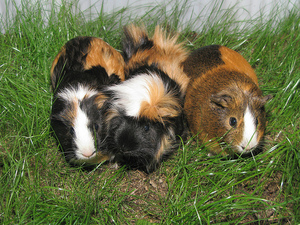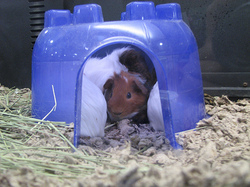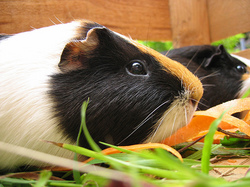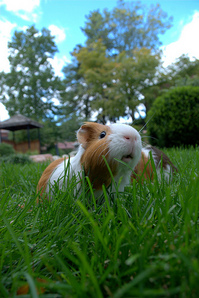Tips for keeping guinea pigs happy and healthy

Photo by Flickr user Photon
Guinea pigs were domesticated a long time ago in South America for food, and they are still eaten there today. Despite several attempts to export the consumption of guinea pig meat to the rest of the world, we just can't seem to get past the cuteness.
There are several breeds of guinea pig, but most of the piggies you will meet are English/American. Their life span can be anywhere between 4 and 10 years, but the average is 5-6. The sounds they make have fabulous descriptions such as chutt, tweet, purr and chirp. They also scream and whine when being picked up because they mostly prefer to keep their feet on the ground.
The key to a happy and healthy piggy is a balanced diet and a clean environment.

Photo by Flickr user Micah Sittig
Picking the right type of Housing
Hard floors at least two by three feet wide lined with bedding are best. My favorite type of bedding is paper pulp which is absorbent, doesn’t hurt their lungs and is widely available. Their bedding should be changed every one to two days because they poop a lot.
Their cages should be cleaned out with diluted soap and water at least once per week, and their water bottles should be cleaned out daily. They should have a nice box inside for them to hide in. Since they are not very impressive jumpers or climbers, the cage can be open on top with walls only about 10 inches high (though they should be open wire to allow for good ventilation).
Living conditions
Optimum temperature is 65-75 degrees (they can get heat stroke if it gets over 85 degrees). In the wild they live in groups of five to 10, but they also thrive as solo pets. I advise against housing males and females together unless you are serious about becoming a guinea pig breeder.They can start making babies at 2-3 months old, and they will! It’s very easy to tell the sexes apart if you just take a peek, because the males have obvious testicles.

Photo by Flickr user Johan Larsson
Dietary needs
Feeding piggies a proper diet is extremely important. They should have a never-ending supply of hay (Timothy Hay is best). Hay is imperative for their digestion and dental health. Their teeth grow continuously, so without the hard fiber to grind them down, their teeth can easily overgrow.
Guinea pigs must also be offered a commercial pellet food (1/8-1/4 cups per day is a good starting place) that is specific to guinea pigs, since other types of rodent or rabbit food will not have all the nutrients they need. Guinea pigs can also have a few tablespoons of treats per day. Oranges, parsley, romaine, green/red leaf lettuce are excellent sources of vitamin C. Other fruits and veggies such as apple, carrot tops, cabbage, spinach, beet greens, chicory and kiwi can also be given in small amounts for variety.
A major dietary consideration for guinea pigs is adequate intake of vitamin C. Guinea pigs are not capable of manufacturing vitamin C and will even get scurvy if we don’t supplement them properly. Piggies should be given produce that is high in vitamin C daily as well as a commercial guinea pig vitamin C supplement (I highly recommend the Oxbow tablets). Even though pellet food is supplemented with vitamin C, it degrades over time in storage, so you can’t count on it. Many websites recommend supplementing the drinking water with vitamin C. I advise against that because it helps promote bacterial growth. Also, the amount of vitamin C decreases rapidly once it is suspended in water and exposed to the air.

Photo by Flickr user Lauren Keith
Grooming
Guinea pig grooming and upkeep is simple. If you have one of the long-haired breeds you should be brushing a few times per week. Most guinea pig owners can get away with only clipping toe nails on occasion.
Special considerations
Guinea pigs are pretty stable pets, but there are a few common illnesses, so it’s a good idea to know what to look for. A lot of illness in guinea pigs is related to inadequate vitamin C intake, which is completely preventable. They are also very prone to upper respiratory disease. They should not be housed with bunnies, cats or dogs. Not only are these animals a threat to the guinea pigs in general, but they can also give them bordatella. Guinea pigs have very sensitive GI tracts and don’t appreciate diet changes. If a guinea pig stops eating, he is in big trouble and should be seen right away.
Guinea pigs are one of my all time favorite pets. They give a lot of love in return if you take the time to form a bond with them. They are also pretty resilient if you take good care of their environment and diet (vitamin C, vitamin C, vitamin C).
I recommend them to anyone!
Dr. Lyssa Alexander treats small and exotic animals and pocket pets at All Creatures Animal Clinic.


Comments
LIz Brauer
Sat, Jan 15, 2011 : 11:45 a.m.
Lyssa, your articles show how much joy you get from pets!
A2K
Sat, Jan 15, 2011 : 9:37 a.m.
GP's are wonderful pets - we had one for years named Alex who would get really excited when he'd hear my husband's car coming up the driveway after work: Alex would run in circles singing and squeaking and would excitedly chirp away until he got some attention from "Dad"...he was a sweet little soul...if you take the time and are quiet and patient, they have wonderful personalities.